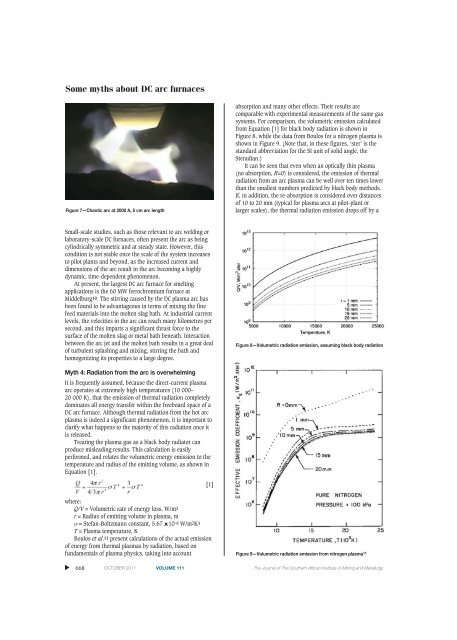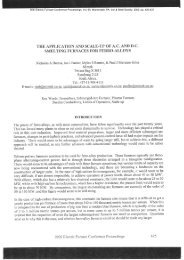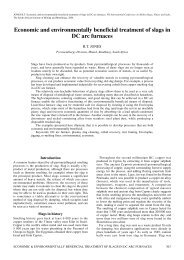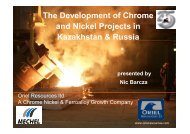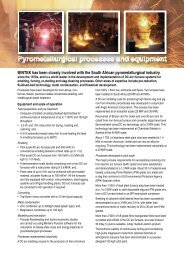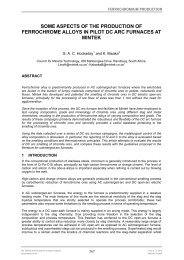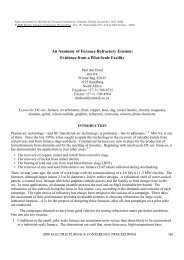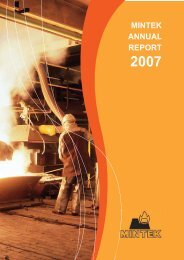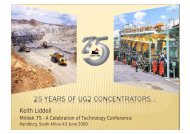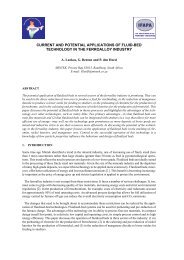<strong>Some</strong> <strong>myths</strong> <strong>about</strong> <strong>DC</strong> <strong>arc</strong> <strong>furnaces</strong>Figure 7—Chaotic <strong>arc</strong> at 2000 A, 5 cm <strong>arc</strong> lengthabsorption and many other effects. Their results arecomparable with experimental measurements of the same gassystems. For comparison, the volumetric emission calculatedfrom Equation [1] for black body radiation is shown inFigure 8, while the data from Boulos for a nitrogen plasma isshown in Figure 9. (Note that, in these figures, ‘ster’ is thestandard abbreviation for the SI unit of solid angle, theSteradian.)It can be seen that even when an optically thin plasma(no absorption, R=0) is considered, the emission of thermalradiation from an <strong>arc</strong> plasma can be well over ten times lowerthan the smallest numbers predicted by black body methods.If, in addition, the re-absorption is considered over distancesof 10 to 20 mm (typical for plasma <strong>arc</strong>s at pilot-plant orlarger scales), the thermal radiation emission drops off by aSmall-scale studies, such as those relevant to <strong>arc</strong> welding orlaboratory-scale <strong>DC</strong> <strong>furnaces</strong>, often present the <strong>arc</strong> as beingcylindrically symmetric and at steady state. However, thiscondition is not stable once the scale of the system increasesto pilot plants and beyond, as the increased current anddimensions of the <strong>arc</strong> result in the <strong>arc</strong> becoming a highlydynamic, time-dependent phenomenon.At present, the largest <strong>DC</strong> <strong>arc</strong> furnace for smeltingapplications is the 60 MW ferrochromium furnace atMiddelburg10. The stirring caused by the <strong>DC</strong> plasma <strong>arc</strong> hasbeen found to be advantageous in terms of mixing the finefeed materials into the molten slag bath. At industrial currentlevels, the velocities in the <strong>arc</strong> can reach many kilometres persecond, and this imparts a significant thrust force to thesurface of the molten slag or metal bath beneath. Interactionbetween the <strong>arc</strong> jet and the molten bath results in a great dealof turbulent splashing and mixing, stirring the bath andhomogenizing its properties to a large degree.Figure 8—Volumetric radiation emission, assuming black body radiationMyth 4: Radiation from the <strong>arc</strong> is overwhelmingIt is frequently assumed, because the direct-current plasma<strong>arc</strong> operates at extremely high temperatures (10 000–20 000 K), that the emission of thermal radiation completelydominates all energy transfer within the freeboard space of a<strong>DC</strong> <strong>arc</strong> furnace. Although thermal radiation from the hot <strong>arc</strong>plasma is indeed a significant phenomenon, it is important toclarify what happens to the majority of this radiation once itis released.Treating the plasma gas as a black body radiator canproduce misleading results. This calculation is easilyperformed, and relates the volumetric energy emission to thetemperature and radius of the emitting volume, as shown inEquation [1].[1]where:Q/V = Volumetric rate of energy loss, W/m3r = Radius of emitting volume in plasma, mσ = Stefan-Boltzmann constant, 5.67 x 10-8 W/m2K4T = Plasma temperature, KBoulos et al.11 present calculations of the actual emissionof energy from thermal plasmas by radiation, based onfundamentals of plasma physics, taking into accountFigure 9—Volumetric radiation emission from nitrogen plasma 11▲668 OCTOBER 2011 VOLUME 111 The Journal of The Southern African Institute of Mining and Metallurgy
<strong>Some</strong> <strong>myths</strong> <strong>about</strong> <strong>DC</strong> <strong>arc</strong> <strong>furnaces</strong>further two to three orders of magnitude. As a result of this,a large fraction (>99%) of the radiation emitted by theplasma in the <strong>arc</strong> is re-captured in the body of the <strong>arc</strong> beforeit escapes into the freeboard. The <strong>arc</strong> jet directs this energyvery strongly down at the molten bath surface, where it canbe transferred directly to the bath material by close-proximityradiation, convection, and conduction. The <strong>arc</strong> is thereforeextremely efficient at converting electrical energy into thermalenergy and delivering it into the molten bath directly beneaththe electrode, without losing too much to the <strong>furnaces</strong>idewalls and roof in the process.Experimental evidence supporting the radiation from thehot bath surface as the primary mechanism of heat transferto the freeboard surfaces in the <strong>DC</strong> <strong>arc</strong> furnace has beenpublished previously12.Figure 10 shows measured data from a copper fingercooler inserted into the freeboard space of a pilot-plantfurnace. Due to the very high thermal conductivity of copper,its response to changing energy flux from the furnacefreeboard would be expected to be very rapid. As can beseen, the shutdown of power at 600 s results in virtually nochange in the measured energy losses at the cooler over asignificant period of time (25 min). This supports theconjecture that it is radiation from the bath surface, and notdirectly from the <strong>arc</strong>, that is the dominant effect within thefreeboard spaces of <strong>DC</strong> <strong>arc</strong> <strong>furnaces</strong>.Myth 5: The <strong>arc</strong> punches a hole right through the slagIn the same way that a jet of compressed air can displacewater, so it is reasonable to expect that a plasma <strong>arc</strong> shouldbe able to displace some of the slag onto which it impinges.Of course, the real question is: how much is displaced?Bowman13 quotes the work of Maecker8 that shows thethrust of the <strong>arc</strong> to be proportional to the square of thecurrent, as shown in Equation [2].where:T = <strong>arc</strong> thrust, NI = <strong>arc</strong> current, kA[2]Figure 11—Dimensions of the cavity formed by <strong>arc</strong> jet thrust at differentdiameter: depth ratios, in the case of a current of 40 kA (dotted lines) or80 kA (solid lines) and a slag density of 3500 kg/m 3 and thickness of60 cmAssuming that the shape of the cavity is a paraboloidwith radius r and height or depth h, the volume V of thedisplaced slag may be expressed as:The thrust of the <strong>arc</strong> may be equated to the buoyancyforce generated by the absence of slag from the cavity (i.e.the volume multiplied by the slag density and gravitationalacceleration).[3][4]where:ρ = slag density, kg/m3g = standard gravitational acceleration, 9.81 m/s2The shape of the depression in the <strong>arc</strong> attachment zone(AAZ) is defined by the formulae for the diameter and depthin Equations [5] and [6] respectively, where ψis the diameterto depth ratio.[5][6]TransactionPaperFigure 10—Measured transient energy losses from a copper fingercooler 12Figure 11 shows the dimensions of the <strong>arc</strong> cavity that isformed, under different assumptions of the diameter to depthratio. A ratio of 6:1 is based on our assessment of typical <strong>arc</strong>depressions seen in photographs of <strong>arc</strong>s from the <strong>Mintek</strong>pilot plant, and a ratio of 1:1 is the stability limit14 for gasjets impinging on liquid surfaces.The 1:1 ratio is an extreme case, and the 6:1 ratio is morelikely. For slags of reasonable density and moderate depths(typically around 60 cm), it is very unlikely that all of theslag is blown away by the <strong>arc</strong>, even when the current is veryhigh.Myth 6: A <strong>DC</strong> <strong>arc</strong> furnace is a constant-resistancedeviceThe electrical behaviour of a <strong>DC</strong> <strong>arc</strong> furnace may be modelledas an <strong>arc</strong> in series with a layer of slag. The <strong>arc</strong> has aparticular resistivity for a given gas composition andThe Journal of The Southern African Institute of Mining and Metallurgy VOLUME 111 OCTOBER 2011 669▲


